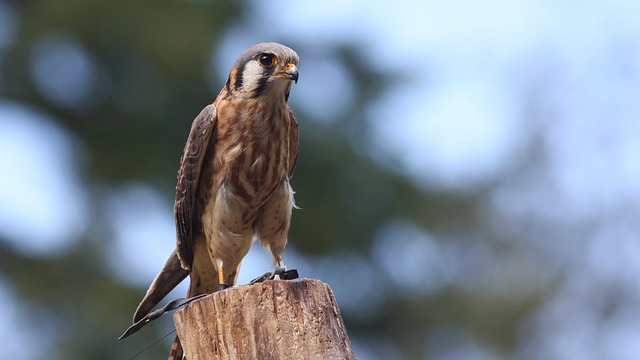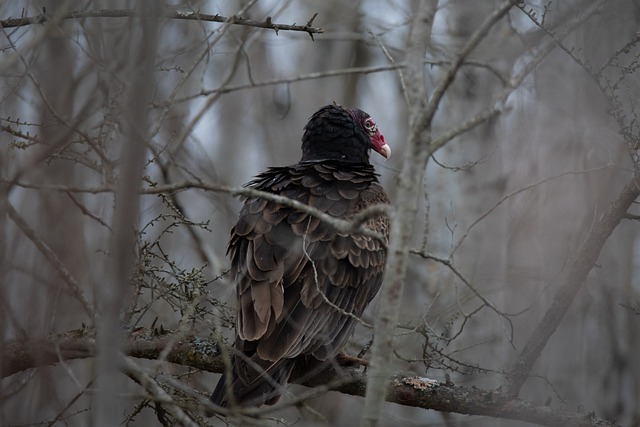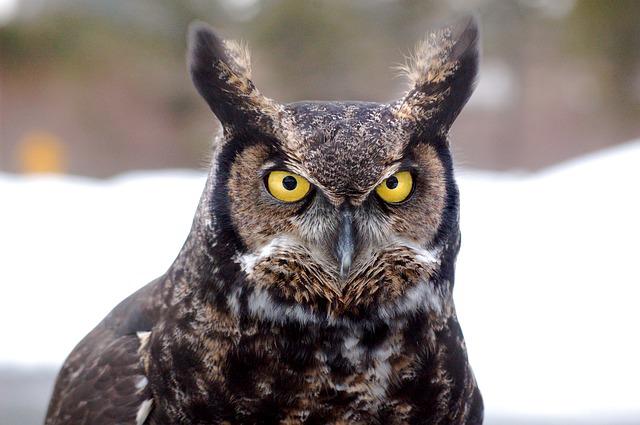Colorado is known for its unique wildlife, specifically when it comes to birds. According to the Colorado Field Ornithologists and CBRC (Colorado Bird Records Committee), the region is home to about 511 different species of bird.
Focusing on this, we can probably assume that the diversity of Colorado birds of prey would be astounding, and it is!
If you really want to learn further about raptors and birds of prey in Colorado, you’re here for a surprise gift! In this article, we’ll take you on a tour of Colorado’s most incredible species.
Let’s get started!
| Image | Name |
|---|---|
 | Golden Eagle |
 | Bald Eagle |
 | Sharp Shinned Hawk |
 | American Kestrel |
 | Turkey Vulture |
 | Osprey |
 | Eastern Screech Owl |
 | Peregrine Falcon |
 | Great Horned Owl |
Birds of Prey in Colorado
1. Golden Eagle

In the state of Colorado, golden eagles live throughout the year.
These eagles are distinguished by their predominantly light brown and dark brown feathers, yellow paws, and black downward-pointing beak. Females are instead the bigger of the two birds, with males being around 33% smaller and lighter.
These eagles spend most of their day on mountains and open moorlands throughout Scotland and much of North America.
| Scientific Name | Aquila Chrysaetos |
| Size | 70 to 82 centimeters |
| Wingspan | 190 to 212 centimeters |
| Weight | 3.7 to 5.3 kilograms |
Golden eagles eat carrion; however, it is not their first variety of food while looking for prey. If they come across a dead carcass, they will consume it, with their typical diet comprising of birds, smaller animals, and occasionally bigger prey.
These eagles have been recorded to live for approximately 14 years in the wild, and in captivity, they may survive into their early 30s, with the oldest reported to be 32 years old.
2. Bald Eagle

During the non-breeding period, bald eagles may be spotted throughout Colorado.
The bald eagle’s feathers seem to be dark brown all around the body and wing, with white plumage on the head and tail, as well as the distinctive yellow feet and beak. Both sexes of bald eagles have similar appearances.
| Scientific Name | Haliaeetus Leucocephalus |
| Size | 90 to 108 centimeters |
| Wingspan | 180 to 250 centimeters |
| Weight | 3 to 6.3 kilograms |
These eagles are commonly found near lakes and reservoirs with a lot of fish, as well as adjacent woodlands. You may likely discover them near liquified lakes and foraging around reservoirs, coasts, and rivers in the wintertime.
These eagles are primarily birds of prey, which usually hunt other birds, medium-sized animals such as hares and rabbits, as well as other creatures such as fish, reptiles, and even carrion when their alternatives are scarce.
Bald eagles are often referred to as fish eagles since their diet consists solely of fish, but because flesh seems to be the only food they consume, these eagles are also classified as carnivores.
In the wild, bald eagles may live for up to 20 years.
3. Sharp Shinned Hawk

Sharp-shinned hawks remain year-round inhabitants throughout much of Colorado, with the exception of the state’s northern region, where they travel.
These hawks may be identified through their gray wings and brown, back and white abdomen and chest, and yellow feet. Females resemble males however are around one-third bigger.
| Scientific Name | Accipiter Stratus |
| Size | 23 to 37 centimeters |
| Wingspan | 42 to 68 centimeters |
| Weight | 82 to 220 grams |
Habitat & Food
Sharp-shinned hawks inhabit open deciduous woodlands, mixed or coniferous woods, thickets, and margins.
These hawks will frequently consume birds ranging in size from a robin to a sparrow, and even in rare situations, birds as large as quails. They occasionally consume snakes, bats, lizards, squirrels, rodents, frogs, and big insects.
Sharp-shinned hawks normally live about 5 to 6 years on average, while some might survive for ten years or more in the correct circumstances.
4. American Kestrel

All year, American kestrels may be seen across Colorado.
American kestrels are distinguished through their spotty white, black, gray, and orange feathers, which include an orange back with a black horizontal design, black tail feathers, gray wings, and orange flanks with a gray and white head that seems to have two black dividing lines vertically above both eyes.
Females are generally light brown in color.
| Scientific Name | Falco Sparverius |
| Size | 20 to 24 centimeters |
| Weight | 115 to 125 grams |
| Wingspan | 50 to 60 centimeters |
American kestrels live in a wide range of semi-open or open settings, including woodland clearings, deserts, and farms.
They consume small animals, including shrews and woodmice, insects, tiny birds, and earthworms, while voles become their primary food source.
Wild American kestrels usually survive for about five years, although captive variations can survive for 17 years or more.
5. Turkey Vulture

When turkey vultures mate, they may be found throughout much of the Colorado region.
Turkey vultures possess brownish/black feathers having silver/gray lines on the bottom of their wings, which adds contrasts to their entire look.
The face is pink/red, having black accents on the skull and a pale white beak.
These species are monomorphic, which means they all appear the same except for their reproductive organs.
| Scientific Name | Cathartes Aura |
| Size | 62 to 81 centimeters |
| Wingspan | 1.6 to 1.8 meters |
| Weight | 1.5 to 2 kilograms |
Turkey vultures may be located all over North America, mostly in woodland and open settings, although they will even dwell in lower-altitude mountain regions.
Carrion is the principal source of food for turkey vultures, although they also consume insects, amphibians, birds, and dead reptiles. These vultures are like fresher carrion in general, although like other vultures, they can devour the same cadaver over many days.
Turkey vultures have been seen to live for approximately 30 years in captivity and about 16 years in the wild.
6. Osprey

Ospreys chose the northeastern portion of Colorado as a nesting location, while the rest of the state serves as a migration route.
Ospreys are distinguished via their brown wings and back, white throat and abdomen having brown hints around the neck, yellow eyes, and black beak. Males and females have nearly similar appearances, while females are typically 20% bigger.
| Scientific Name | Pandion Haliaetus |
| Size | 50 to 65 centimeters |
| Wingspan | 170 to 185 centimeters |
| Weight | 1 to 1.5 kilograms |
Ospreys may be spotted nearby big bodies of water sources such as rivers, lakes, and coastal locations.
What they consume consists primarily of medium-sized fish like trout, salmon, mullet, and flounder, as well as the occasional smaller one.
These large birds have been seen to survive for an average of 15 to 20 years, with the maximum documented age reaching 32 years.
7. Eastern Screech Owl

Eastern screech owls may be located year-round in the northeastern and eastern boundaries of Colorado.
Eastern screech owls are distinguished by their predominantly gray coloring. Females are typically bigger and also have brown-colored plumage.
These owls inhabit broadly mixed woodlands, forested suburban areas, parklands, deciduous forests, and riparian woods near wetlands and streams.
| Scientific Name | Megascops Asio |
| Size | 16 to 25 centimeters |
| Wingspan | 49 to 61 centimeters |
| Weight | 121 to 244 grams |
Eastern screech owls feed on tiny creatures such as birds and mammals, frogs, lizards, insects, tadpoles, crayfish, and earthworms.
The average lifespan of these owls within the wild is 14 years.
8. Peregrine Falcon

Peregrine falcons can be found in southwest Colorado all year, northwest Colorado just while mating, sections of southeast Colorado during their non-breeding period, and the rest of the state travel to some of these places.
Peregrine falcons are distinguished via their black head, wings, and back, as well as their yellow feet, black and yellow beak, and patterning back and white feathers on the abdomen.
Females are again the larger of the two, while males are around 33% smaller.
| Scientific Name | Falco Peregrinus |
| Size | 38 to 48 centimeters |
| Wingspan | 95 to 110 centimeters |
| Weight | 600 to 1300 grams |
Peregrines inhabit a wide range of habitats, including scrubland, seashores, grasslands, tundra, mangroves, dry woods, deserts, marshes, and rugged mountains.
Peregrine falcons primarily feed on other smaller birds such as shorebirds, ducks, pigeons, other smaller animals, and in rare instances, carrion.
Peregrine falcons can survive in captivity for about 16 years and in the wild for 5 to 6 years.
9. Great Horned Owl

The Great Horned owl may be seen across Colorado at any time of year. It is among the most well-known owls and can be found from the Arctic to South America.
Their physical body size ranges from 18 to 25 inches, and they have a wingspan of about five shoes. There is a pretty considerable disparity in body weight between men and women.
| Scientific Name | Bubo virginianus |
| Size | 38 to 48 centimeters |
| Wingspan | 95 to 110 centimeters |
| Weight | 600 to 1300 grams |
The feeding options for a Great-horned owl are vast. They will almost certainly devour any form of tiny to medium-sized pet. Colorado’s Predators.
Conclusion
This brings us to the end of the list of the top birds of prey across Colorado. As you’ll see, this region’s diversity of avian fauna is just amazing!
But with that guide, you must have a good sense of what to experience during bird watching nearby! We are glad you liked our Colorado bird of prey guidebook.
FAQ
Do hawks consume dogs?
Puppies, dogs, kittens, cats, guinea pigs, ferrets, rabbits, ducks, and chicks are all at risk since hawks, and their kin is opportunistic creatures.
Last Updated on March 22, 2023 by Lily Aldrin
